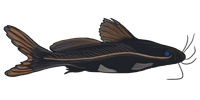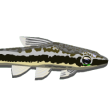raglanroad wrote:Because the knowledge you have of the genes of the fish is severely limited - approaching zippo - you are dealing with phenes. If it's not for restocking the wild, all you need to do, is a "Pierre Brichard", and produce nice lines of healthy zebras for fun and profit.
Get rid of those fish producing deformed and poor gainers, be they that for any reason, and away you go. At worst, sell them as single trophies.
And that's what this is really all about. You'll can linebreed the good ones to find the bad and weed it out thoroughly.
Then you'll have strong zebras that breed well in tanks, and get a good buck for a while, even when other breeders are selling lots of them.
good luck and have fun in the hobby.
Dave
In no way. I don't know it, that's the point. At most, angelfish breeders have what they call "wild type" presumed scalare, but the domestic fish under that phenotype name are far removed from wild, and are a specific domestic phenotype of plain silver, usual barring, plain fin, etc.
Dave,
In what way is your knowledge of the genes of fish also not severely limited - approaching zippo?
the genotype given is (+/+) for everything on such a fish, meaning having genetics not resulting in any of the known sport mutation phenotypes, and only in regard to these mutations. It's a "negative" on having any of the recognized sport mutations, that's all.
I don't profess to have true knowledge; lucky for me.A passing familiarity with some abstract molecular genetic terminology is not true knowledge.
So I didn't grow that fin on a petri dish. I didn't make the software and I don't run a lab. That's why you take a bit of fin from a fish, and you pay a small fee to a lab, and they send the report to BOLD account and software indicates if there is reason for seeing your collection of samples as from one or more species.Bar coding has it's uses but you are wrong to say, "All I need to do is bar code snip" Dave, all you can do is submit tissue sample to others who are doing that work. You aren't able to do it yourself.
Larry, you is too generousAll you know is that gene are to genotype as phenes are to phenotype.
You'll "get it" soon, I'm sure. There is a problem with your explanation, Larry.Each are merely names given to the collection of DNA base pairs that may form genes, some sequence of genes may form phenes and some sequence of phenes may form portions of phenotypes.
Colllection of base pairs "form' genes.
OK. As constituent elements of a set.
Onward;
"Some sequence of genes may form phenes".
????
No, Larry, you can never say that.
Code sequences are not constituent elements of a whole that is a phene. They are not constituents of phenes in the same way as your first sentence uses the word "forms" . You have wrongly equivocated.
Then you go back to using the word "form" in the first way again, with this: "Some sequence of phenes may form portions of phenotypes".
Here you use "forms" once again, correctly ( or rather, coherently, again) , as constituent parts "form" a whole.
So it adds up lacking meaning. It's not nonsensical; the problem is that it's incoherent. I hope you undestand that "incoherent" does not mean "stunned", 'wacky" , or anything like that. It's just that you equivocated wrongly, and so produced meaningless jabber.
A phene, a phenotype, or a phenome..none...none of these are a collection of DNA or of transcript.
that's why we're not talking about "most" of these building blocks; only a very small snippet.
Most of these building block are not known by anyone, including molecular geneticists.
the promise is huge, so % yield is not insignificant. it requires time.This science is still in it's infancy. Mapping of the human genotype was an impressive technical accomplishment but has not yielded much of it's promise yet in improving the human condition.
Larry, can you offer any support for this blanket statement ? And what do you mean "abstract concepts " ? Of course there will be some concepts that are not put to practical application at any given time. I don't understand what you're talking about. ? Would barcoding help a little breeder produce zebra fry right now ? no, of course not ! And neither would the complete genome in a sac. What are you trying to say ? Nobody was hinting anything about using abstract molecular genetical concepts to breed a few zebras, guy.
No one is yet in the position to put any of the the abstract concepts of molecular genetics to practical use in this hobby to do their best to breed in captivity a few Hypancistrus species to help keep them in the fish hobby.
Now..did anything I introduced have possible merit vis a vis zebra fry production ? I think so.
Altricial trout fry food is being studied. They do not like some of the coatings on feed that precocial fry do eat. They do like the gelatin based feed coating, not the protein link stuff that precocials eat. So if you're seeing altricial-tendency fry, at some point during development, they may improve with a different feed than the precocials.
Nothing much has come from molecular biology? Wow. That's all I can say to that bald assertion. Barcoding helps distinguish species, as they may be defined, with solid evidence to back it.About the only useful results of the advances in molecular genetics has been to help clarify the evolutionary phylogenetic relationships between some groups of fish, no small achievement, to be sure.
I believe I have already stressed the point to you, that we cannot copy the habitat and so on. We can't preserve all the original normal phenotypes even with a large number of individuals. Isn't that what I've been saying, Sir ? Glad you agree.Not you, not me nor anyone else is in a position to begin extrapolating how to correctly begin modest hobby breeding projects that would be equivalent of natural selection.
The fish aren't extinct in nature yet and are not very likely to become so in our lifetimes; the populations are inclusive enough to prevent unnatural selection from occurring in the wild.
Yes, like good dog breeders - that's what I was getting at. With German Shepherds, they have reduced hip dysplasia markedly in short order, by giving a numerical rating system of good phenotype for hips, that is adjusted later because of what his or her progeny shows. The breeder merely is restricted to choosing matings that between the pair have a combined score of 200 or less on the z rating. So a great dog otherwise, but has a 'z' rating score of 120, which is not great for breeding for good hiips, can be mated with a great female with a "z" rating score of 80...total 200. That way good phenes are not lost because of bad ones that are being rejected.
Besides, even using the most basic of animal husbandry breeder selection techniques will be adequate for fish hobbyist needs for quite some time into the future.
In a few years they got good progress in removing unwanted bits of complex traits, without needing to know about the genes, or even about balancing the complex things, like bone dimensions and muscle attachments, thrust from the rear legs matching the front leg reach...you get a dog with good hips, and even hidden bad stuff is removed through attrition.
The aim is to remove and so improve. Not preserve.
That is one reason why I said that it's not about preserving the zebra genome with captives of a certain number, which would indicate genetic diversity approaching that of an infinite population. Remember ?
The ideas being floated about captive breeding programs and REGISTRY, seemed to me to indicate something a LITTLE bit more than basic husbandry , EH ? So what is all this about, if it's not about doing more ?
Be precise, Larry . Show the lines you are talking 'bout, please. Remember that if you have ever used such terminology yourself, then you AUTOMATICALLY fall into the same nasty characterization you made of me ! So if I find that you've used such terms as you point out that I used..you fit the description you just gave
Using the terminology as if you really know what you are talking about when even the scientists doing the work do not make such grandiose claims is obfuscation at best and mental masturbation at worst.
Perhaps you'll find that the dirty cloth will cling all the tighter when flung about your shoulders.
I'm insulting ? lol. I'm being nice. I might try to tease or have fun with you but I don't think I'm being hateful. I don't think I've really given you reason to turn so sour like that and offer such ad hom derogatory speeches.A little knowledge is a dangerous thing and it is a double edged sword which cuts both ways. I don't know why you have such a drive to try to insult the intelligence of people on internet forums but I have known you long enough to know you enjoy it.
Can you support your claim about the "grandiose claims" I've made here, that scientists doing the work do not make ? Which grandiose claims, Larry ? I'm interested. Heiko's final reply was that he considers it correct, what I said, but nobody is paying him to do it large-scale.
I noted and rejected some ideas floating about in your aimless thread with the wrong title and an opening post more heading towards the question of whether Hypancistrus are really illicit, despite Brazil's declarations. Also I agreed with some ideas.
1/ rejected the environmentalists' idea of self-sustaining hippie villages complete with strolling minstrels to save everything
2/ rejected the idea that we should even try to preserve the genome in captivity.
3/ rejected the idea that this project or any number of other initiatives would "fix" Brazil.
4/ entertained the idea of producing good breeding lines of zebras in the hobby. Hopefully you can produce strong healthy fish like nice yellow lab lines, even from your own few fish each.
Is that so fanciful ? And to barcode some fins when possible.
In a few posts , along with the fun, I've introduced to the discussion - and provided literature on - some concepts - concepts such as that of treatment of precocial and altricial fry in their early ontogeny, which is aquaculture specific. Slow development of zebra fry, I thought might be a subject of interest. Literature about defining "domestication" and the degrees of it as it may occur in fish. Barcoding. A very very neat breeders' method of manipulating the genetics from basically in the dark.
When I compare that to what you have given the discussion, I'm not ashamed. What have you given to the discussion other than bad temper ? My ideas are for discussion, or to be ignored, either is fine with me.
Noted that this reply from you, Larry - this flowery ad hom offering - contained not a speck of substantiation - nor any response to my previous answers to your posts.
I've asked to have my membership deleted, so I'll probably just read your response showing my grandiose, baseless claims, and learn, eh ?




